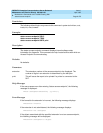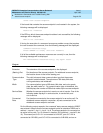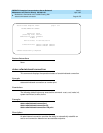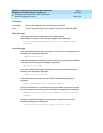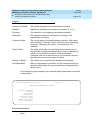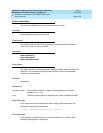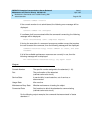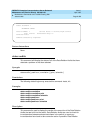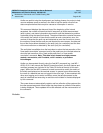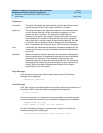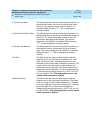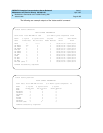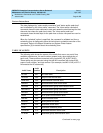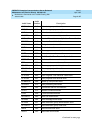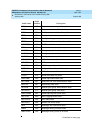
DEFINITY Enterprise Communications Server Release 5
Maintenance and Test for R5vs/si
555-230-123
Issue 1
April 1997
Maintenance Commands and Trouble-Clearing Aids
Page 8-381status audits
8
Audits are useful during the development and testing phases of a project to help
uncover software errors as well as in the field to help the switch recover from
data corruption before that corruption causes an interruption in service.
This command displays the date and time of the beginning of the interval
requested, the number of times that the full sequence of audits was executed
(audit cycles), and status information about each audit that detected a problem
or aborted during the specified interval. The status information contains the name
of the audit, the number of times that the audit ran and corrected an error, the
number of times that the audit ran and detected an error that it could not correct,
the number of times that the audit ran and aborted for some reason, the date and
time of the first problem detected by the audit (only for cumulative) and the time
of the most recent error detected by the audit (only for cumulative).
The audit data is available since the last reboot or since the last execution of the
"clear audits cumulative" command, and for the peak hour since the last reboot or
since the last execution of the "clear audits peak-hour" or "clear audits
cumulative" command. Note: This data is not cleared on single process
restarts, warm starts, cold 2 restarts, cold 1 restarts, or processor
interchanges.
Audits can be executed directly using the "test MO" command (e.g.
test MO l
8192 p 512 t 0
will execute the Station Connections Audit, the audit lnames and
numbers (pnames) are included in the Table Of Audits at the end of this main
page). When the "test MO" command is used to execute an audit, the results of
the audit are displayed on the terminal screen. In general, errors discovered as
the result of a demand test are not logged in the error logs. To be consistent with
other error logging and to avoid confusion, errors that are discovered as the
result of a demand test executing an audit are not included in the data displayed
by this command.
The screen does not automatically update, and is a reflection of the system at the
time the request was made. More audits may have been run while the information
is being displayed. These updates will not be reflected until the next execution of
the command.
Defaults
None



